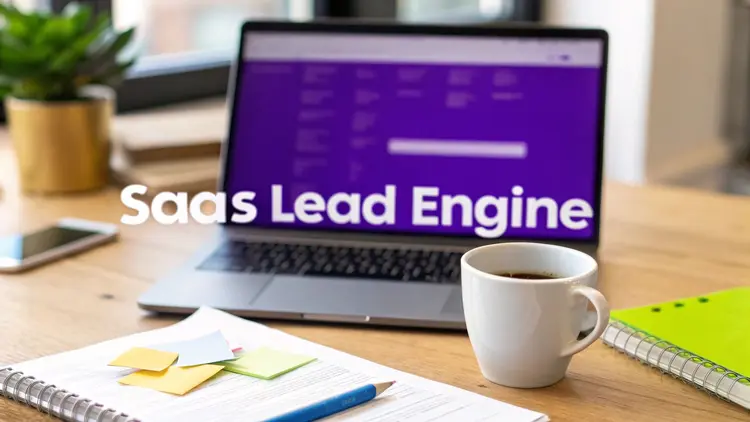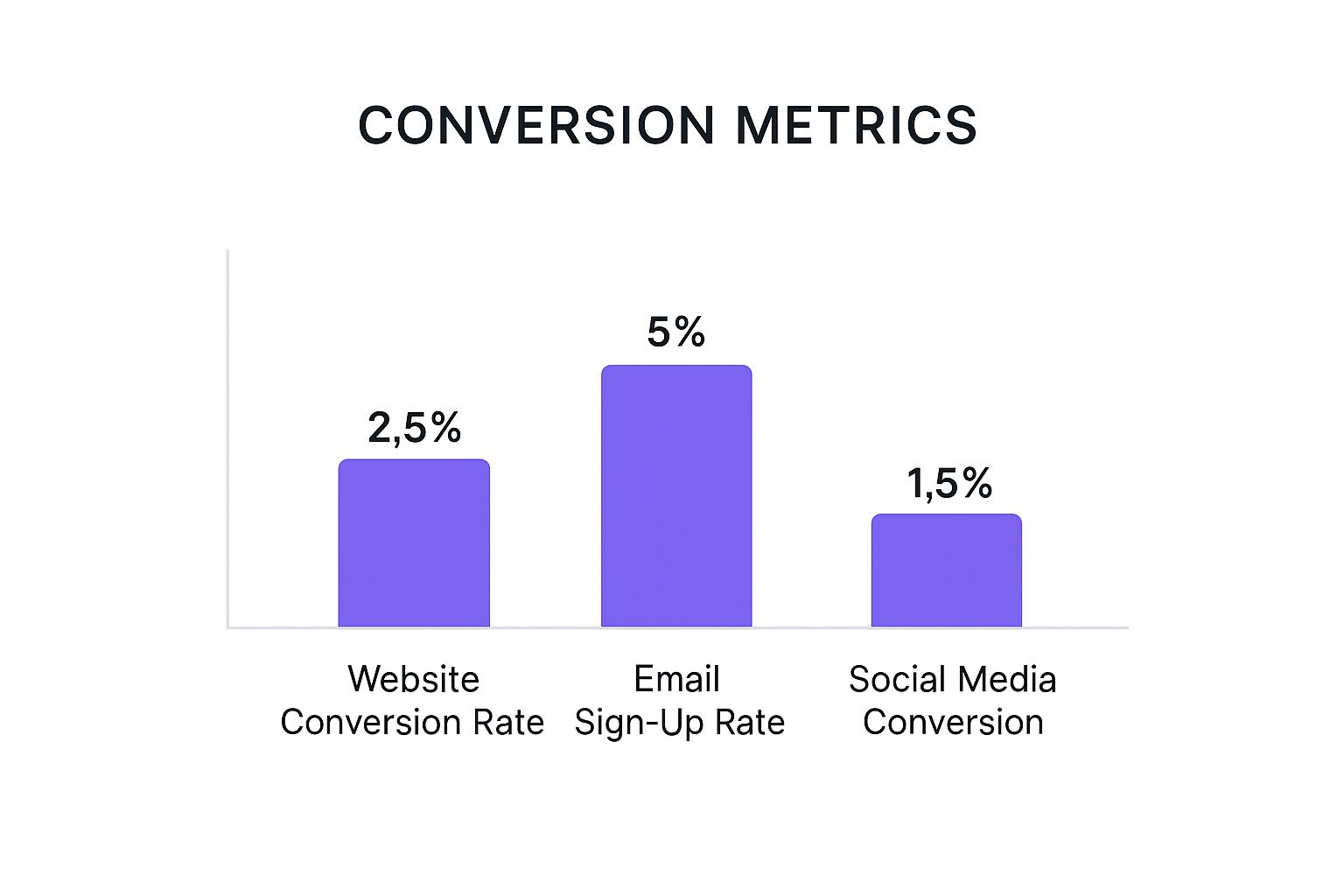Lead Generation for SaaS: Build Systems That Convert

What's Really Happening in SaaS Lead Generation Right Now
The old ways of generating leads? Let's just say they're gathering dust. I've been talking with growth leaders at a bunch of successful SaaS companies, and one thing is crystal clear: Chasing vanity metrics like your total website visitors is a recipe for frustration. The real winners are laser-focused on qualified leads. Think about it – half of all marketers now say lead generation is their top priority, but the game has changed. Let's dive into what the smart folks are doing differently, and the real numbers behind their success. Forget the hype, let's talk achievable goals and actual costs.
This infographic shows average conversion rates across three key channels: website, email, and social media.
Email sign-ups convert like crazy at 5%. Permission-based marketing is king! Websites still pull their weight at 2.5%, but social media lags at 1.5%. That tells me we need a smarter approach to social engagement.
The Current State of Lead Generation
Okay, let's get down to brass tacks. The focus on lead generation for SaaS is intense. It's not just about getting leads – it's about getting the right leads. This screenshot from Exploding Topics breaks down some key lead generation statistics.

See how important Marketing Qualified Leads (MQLs) are? And how crucial it is to convert those MQLs into paying customers? That's where the rubber meets the road.
Half – that’s right, 50% of marketers – rank lead generation as a top priority. Companies are generating an average of 1,877 leads per month, with 81% qualifying as MQLs. The average cost per lead? Around $198.44. That’s a real investment, so you better make it count. For more insights, check out these lead generation stats.
To give you a better idea, let's talk benchmarks. I've put together a table showing typical lead generation metrics for SaaS companies at different stages:
SaaS Lead Generation Benchmarks by Company Stage
Company Stage | Monthly Lead Volume | MQL Rate | Average Cost Per Lead | Conversion Rate |
|---|---|---|---|---|
Startup | 500-1000 | 60-70% | $150-250 | 1-2% |
Growth | 1000-5000 | 70-80% | $100-200 | 2-3% |
Established | 5000+ | 80-90% | $50-150 | 3-5% |
This table gives you a rough idea of where your company should be, but remember, these are just averages. Your specific numbers will depend on your niche, target audience, and overall strategy.
Moving Beyond Vanity Metrics
Let's talk about a real-world example. Imagine a SaaS company like (hypothetical) SpeakerStacks, which helps professionals use speaking engagements to generate leads. They’re not interested in just anyone who visits their website. They want speakers, consultants, and thought leaders who are actively looking for tools to connect with their audience and turn interest into real business results.
This means focusing on metrics like demo requests, free trial sign-ups, and contact form submissions – actions that show genuine interest. By combining this targeted approach with smart content creation and advertising, SpeakerStacks attracts high-quality leads who are more likely to become paying customers. It’s not about filling the top of the funnel – it’s about making sure the leads flowing through are ready to convert. That's the real difference-maker in successful SaaS lead generation.
Content That Actually Magnetizes Your Best Prospects
Most SaaS companies try to attract everyone with their content. The problem? Appealing to everyone usually appeals to no one. Successful SaaS businesses using content to drive leads understand this key principle: be specific, not broad.
This screenshot from Reach Marketing shows how important targeted content is for getting leads.

It highlights tailoring your content to different buyer journey stages to nurture leads and boost conversions. Good content can increase lead generation by up to 300%, especially with strong SEO using long-tail keywords. A/B testing headlines and personalizing with AI can also increase engagement by up to 47%. For a deeper dive, check out this guide on generating SaaS leads.
Understanding Your Ideal Customer
Let's get practical. Imagine a SaaS company like SpeakerStacks, which helps professionals use speaking engagements to get leads. Their ideal customer isn't any presenter. They're looking for speakers, consultants, and thought leaders wanting to turn audience interest into actual business.
This sharp focus shapes all their content. They create resources specifically for this audience: blog posts on maximizing audience engagement, case studies of speakers using the platform to book more clients, and even downloadable templates for strong presentation call-to-actions.
The Power of Long-Tail Keywords
Think about this: someone searching "presentation software" is in a different place than someone searching “how to generate leads from speaking engagements.” The latter is a long-tail keyword, and it's incredibly valuable for SaaS lead generation companies like SpeakerStacks.
Why? It shows intent. That searcher is actively looking for a solution to a specific problem, making them more open to SpeakerStacks’ message. Targeting these keywords attracts highly qualified leads already interested in what they offer.
Content Formats That Convert
Knowing who you’re talking to is only half the battle. You also need to know how they prefer to consume information. SpeakerStacks knows their audience is busy. They prefer quick, actionable content over long ebooks.
So, they focus on these formats:
Short, impactful blog posts: Actionable tips and real-world examples of speakers generating leads.
Video tutorials: Showing how to use SpeakerStacks to create landing pages that convert.
Downloadable templates: Ready-to-use resources like presentation slides and lead magnet checklists.
These formats deliver value quickly and efficiently, meeting their ideal customer's needs.
Personalization and A/B Testing
Picture two landing pages. One is generic. The other speaks directly to the needs of a specific speaker, like a SaaS founder. Which converts better?
Even basic personalization can dramatically improve conversions. A/B testing helps refine this. By testing headlines, call-to-actions, and even images, you learn what resonates and optimize for maximum impact. This is how you create content that not only attracts visitors but turns them into qualified, sales-ready leads.
Using AI to Scale Without Losing the Human Touch

This Zylo screenshot paints a clear picture: businesses rely heavily on SaaS. That means the competition for SaaS customers is fierce. But here's the key: smart SaaS companies aren't using AI to replace the human touch. They're using it to improve it.
Think of AI as a way to supercharge your team, not make them obsolete. Instead of generic blasts, you can pinpoint your ideal prospects, understand their needs, and give them exactly what they’re looking for. It’s about building stronger connections, at scale.
This shift towards AI and automation is changing the game. AI-powered lead scoring and personalization are becoming the norm. Why? Because they help you focus on the leads most likely to become paying customers. In fact, SaaS companies using AI-powered lead scoring have seen conversion rates jump by 50%.
Tools like chatbots and conversational AI (HubSpot) offer another advantage: 24/7 engagement. This means a better customer experience and more conversions. And in a SaaS market expected to reach $300 billion by 2025, staying ahead of the curve is essential. For more insights, check out these SaaS Statistics.
Real-World AI Applications
Let's get practical. Imagine a SaaS platform like SpeakerStacks (hypothetical example), which helps professionals turn presentations into leads. They're using AI in some clever ways:
Personalized Onboarding: New users don't get a generic welcome. SpeakerStacks’ AI looks at their industry, presentation topics, and website traffic to tailor the onboarding experience. Think custom tips, relevant templates, and case studies that actually resonate.
Predictive Lead Scoring: Forget basic demographics. SpeakerStacks uses AI to predict which leads are most likely to convert. This allows their sales team to prioritize high-potential leads, saving time and effort.
Smart Content Recommendations: The AI engine suggests relevant content – blog posts, tutorials, downloadable resources – based on each user's behavior and interaction. This keeps users engaged and builds stronger connections.
Avoiding the Robotic Feel
Done wrong, AI can feel impersonal. Here’s how to keep it human:
Focus on Solving Problems: Don’t just automate for the sake of it. Use AI to understand and solve user pain points. A chatbot that asks specific questions about speaking goals and offers tailored solutions within the platform? That's helpful, not annoying.
Maintain Authenticity: Automation streamlines things, but genuine human interaction is still key. SpeakerStacks might use AI to personalize emails, but they make sure their sales team follows up with authentic engagement.
Continuous Optimization: AI isn't a "set it and forget it" deal. Regularly review your data, get user feedback, and adjust your AI strategies. Keep it helpful, not intrusive.
SpeakerStacks is a great example of using AI the right way. They're not replacing human connection, they're enhancing it. This balanced approach creates a lead generation engine that’s both powerful and personal, building lasting relationships with their users.
To illustrate the potential ROI of AI, let's take a look at this comparison:
To illustrate the potential ROI of AI, let's look at a comparison of different AI tools:
AI Tools ROI Comparison for SaaS Lead Generation Performance metrics and ROI data for different AI-powered lead generation tools
Tool Type | Implementation Cost | Conversion Rate Improvement | Time Savings | ROI Timeline |
|---|---|---|---|---|
Basic Chatbot | Low | 10-20% | Moderate | Short-term |
Advanced Chatbot with AI Integration | Medium | 25-40% | Significant | Mid-term |
Predictive Lead Scoring Software | High | 40-60% | Substantial | Long-term |
Personalized Onboarding Platform | Medium-High | 30-50% | Significant | Mid-term |
This table provides a general overview. Specific ROI will vary depending on your industry, target audience, and implementation strategy. However, it highlights the potential of AI to significantly impact your bottom line. By strategically implementing the right AI tools, SaaS companies can achieve substantial improvements in lead generation and overall business growth.
Orchestrating Multi-Channel Campaigns That Actually Work
Think of single-channel lead generation like fishing with just one lure. You might snag a few, but you're missing the bigger catch. Winning SaaS companies cast a wider net with multi-channel campaigns, meeting prospects wherever they swim. The beauty is, the ideal mix changes based on your product and audience. Let's dive into what actually works for different SaaS models.

It shows how various channels – email, social media, even direct mail – work together. The key takeaway? Integrated messaging across these channels is crucial for a consistent and effective customer experience. And that consistent messaging is the bedrock of SaaS lead generation.
Case Study: Product-Led Growth
Consider a product like Canva. Their lead generation strategy relies heavily on their freemium model. They draw users in with valuable content marketing (think blog posts and tutorials) offering a taste of the free version. Then, subtle in-product prompts and targeted email marketing nudge users toward paid plans. Social media amplifies this, showcasing user-generated content and highlighting those tempting premium features. It’s a multi-channel symphony that resonates with the product’s self-serve nature.
Case Study: Enterprise SaaS
Now, let’s shift gears to Salesforce. Their game is entirely different. Content marketing establishes thought leadership, attracting enterprise clients. Webinars and events become lead magnets, fostering crucial relationships. Their sales team leverages targeted outreach and account-based marketing (ABM). This approach aligns perfectly with high-value, complex sales cycles.
Case Study: SpeakerStacks for Speakers and Consultants
Imagine a SaaS platform like SpeakerStacks, designed for professionals who generate leads through speaking engagements. Their multi-channel strategy might blend organic content (blog posts, case studies) with email nurturing. Social media becomes a targeted tool, reaching speakers and consultants with laser precision. In-app tutorials and product updates keep users engaged and coming back for more.
Building Your Own Multi-Channel Strategy
The golden rule? There's no magic formula. The best channel mix for your SaaS depends on several factors:
Target Audience: Where do your ideal customers spend their time online?
Product Type: Self-serve or enterprise-focused?
Budget: Some channels demand more resources than others.
Budget Allocation and Pitfalls
Spreading your resources wisely is paramount. A common trap is trying to do everything at once. Focus on a few key channels initially. Track their performance relentlessly and adjust accordingly. Watch for red flags – low engagement, high bounce rates – these are your cues to reassess.
For example, if your social media campaigns are falling flat, don’t throw good money after bad. Dig deeper. Are you targeting the wrong audience? Is your messaging off-key? Consider reallocating those resources to a channel that’s actually delivering results.
Crafting Consistent Messaging
Regardless of your chosen channels, consistency is king. Your brand voice and messaging should feel unified across every touchpoint. Think of it like an orchestra – each instrument plays its unique part, but they harmonize to create a beautiful sound. This creates a seamless customer journey, building trust and reinforcing your brand’s value. It supercharges your SaaS lead generation, guiding potential customers smoothly from awareness to consideration to conversion.
This multi-channel approach is more than just lead generation; it's relationship building. By understanding your audience and meeting them where they are, you build trust and position yourself as a valuable partner. That’s how you transform leads into loyal customers and build a thriving SaaS business.
Converting Visitors Into Leads Worth Talking To
Traffic is fantastic, but let's be honest, it's the qualified leads that really fuel revenue growth. I've seen firsthand the difference between companies drowning in a sea of low-quality leads and those who consistently generate leads that convert. The secret? Understanding conversion psychology and building systems that truly work. Let's dive into the landing page strategies, lead magnets, and progressive profiling techniques that separate the top performers from the rest.
This screenshot from Wikipedia perfectly illustrates the conversion optimization process.
Notice how it emphasizes the iterative nature of improving conversion rates. Analysis, design changes, and testing all work together in a continuous loop. The biggest takeaway? Conversion optimization is a marathon, not a sprint. It requires constant tweaking and refinement to maximize results, especially when it comes to lead generation for SaaS.
Landing Page Strategies That Convert
Your landing page is like a digital handshake. You want to make a strong first impression. Forget those generic templates that scream "stock photo." Your landing page should feel like a natural extension of whatever content or ad brought the visitor there. If someone clicks an ad about lead generation through presentations, the landing page should be specifically about that, not your general homepage. It's all about relevance.
Here’s what I’ve found to be most effective:
Clear Value Proposition: Communicate the benefit of your SaaS instantly. Don't make them hunt for it. What problem are you solving? How will it make their lives easier? For example, SpeakerStacks clearly tells speakers how they can turn audience interest into actual leads. Direct and to the point.
Compelling Call to Action: Don't be shy! Tell visitors exactly what you want them to do. "Get Your Free Trial," "Download the Guide," "Book a Demo" – clear and actionable. The more specific, the better.
Minimal Distractions: Think of your landing page like a tunnel vision towards conversion. Remove anything that doesn't contribute directly to that goal. No unnecessary navigation, cluttered sidebars, or irrelevant links. Keep the focus laser-sharp.
Lead Magnets That Actually Attract
A lead magnet is your bait. It's the valuable resource you offer in exchange for contact information. The key here is value. Nobody wants another generic ebook gathering digital dust in their downloads folder.
Think deeply about your ideal customer's biggest pain points. What can you offer that provides real, actionable solutions? For SpeakerStacks, this could be a template for creating high-converting presentation slides, a checklist for maximizing audience engagement, or a compelling case study showing how other speakers are generating leads from their presentations.
Progressive Profiling: Gathering Information Smartly
Nobody likes filling out endless forms. It feels intrusive and time-consuming. Progressive profiling is the elegant solution. Instead of asking for everything upfront, gather information gradually. Start with the basics (name and email) and then, as they engage more with your content and offers, ask for more details. This builds trust and avoids overwhelming potential leads.
For instance, SpeakerStacks might initially ask for just an email address to download a presentation template. Later, as the lead interacts more, they might ask for company size and industry to personalize future content recommendations. This approach maximizes information gathering without sacrificing conversion rates.
Lead Qualification: Separating the Wheat from the Chaff
Here's the truth: not all leads are created equal. Lead qualification is about identifying the leads most likely to become paying customers. This often involves factors like:
Fit: Does this lead match your ideal customer profile?
Engagement: How actively are they interacting with your content and offers?
Budget: Do they have the resources to invest in your SaaS?
By focusing on these crucial factors, your sales team can prioritize the leads with the highest potential, avoiding wasted time and effort. It’s about having those meaningful conversations with prospects who are genuinely interested and ready to move forward, not just those collecting free resources. This targeted approach maximizes your sales team’s efficiency and supercharges your overall lead generation for SaaS.
Measuring What Matters and Scaling What Works
Let's be honest, most SaaS companies drown in data. But finding the right data, the insights that actually move the needle? That's the real challenge. Metrics like total leads or cost per click are often vanity metrics. They look good on a report, but don't always tell the story of what's truly fueling your revenue growth. Let's dive into the key performance indicators (KPIs) that actually matter to your CEO – the ones directly linked to the bottom line.
This screenshot from Wikipedia highlights the importance of marketing analytics.
It shows how data analysis, statistical modeling, and reporting work together to optimize marketing efforts. Simply put, it's about using data to make smarter decisions, which is essential for effective lead generation for SaaS.
Beyond Vanity Metrics: Focusing on What Drives Revenue
Let's ditch the fluff and focus on the metrics that directly impact revenue. We're talking customer lifetime value (CLTV), lead quality, and true campaign ROI. These are the numbers that separate the high-potential leads from the rest.
Here’s a real-world example. Let's say you're using SpeakerStacks to capture leads after your presentations. Instead of just counting the number of scans, you want to know how many of those scans converted into demo requests, how many demos led to trials, and finally, how many trials became paying customers. That's the complete picture of your lead generation success.
Attribution Models: Giving Credit Where Credit's Due
Knowing where your best customers come from is crucial. Are they finding you through organic search, social media, or paid ads? An attribution model connects the dots, revealing which channels are delivering the most valuable leads – not just the highest volume. This allows you to allocate your budget strategically.
Imagine a lead interacts with your content on LinkedIn, then clicks a Google ad, and finally signs up for a trial after visiting your website. Which channel gets the credit? A well-defined attribution model provides that clarity.
Building a Reporting Framework: Dashboards and Insights
Data without context is noise. A solid reporting framework brings your data to life. Think dashboards visualizing your key metrics, reports tracking campaign performance, and regular analysis uncovering hidden trends. This allows you to identify what’s working, eliminate what’s not, and continuously optimize your lead generation for SaaS strategy.
Here are some essential metrics to track:
Cost per Acquisition (CPA): How much are you spending to acquire a new customer?
Customer Churn Rate: What percentage of your customers are canceling?
Monthly Recurring Revenue (MRR): How much recurring revenue are you generating each month?
These metrics provide a real-time view of your business health and pinpoint areas for improvement.
Scaling What Works, Killing What Doesn’t
Imagine running a multi-channel campaign and noticing that leads from LinkedIn convert at a much higher rate than leads from Facebook. What do you do? You double down on LinkedIn! Shift resources from underperforming channels to those delivering results. This data-driven approach maximizes your ROI and keeps your lead generation engine running smoothly.
This isn't just about crunching numbers; it’s about using those insights to refine your entire approach. Maybe your landing page needs some work. Maybe your lead magnet isn't quite right. The data will guide you. By constantly measuring, testing, and adapting, you build a scalable SaaS lead generation system that consistently delivers.
Your Implementation Roadmap
Look, strategy without execution is just a deck of slides gathering dust. This section gives you a practical roadmap to actually building your SaaS lead generation system, based on where you are right now and the resources you have available. We’ll cover the essential tools, the team structure you'll need, and how to dodge those common implementation pitfalls that can trip up even the best-laid plans.
Building Your Lead Generation Engine
First things first: who's on your team? For a smaller SaaS, this could be a marketing manager juggling multiple roles, a sales rep, and maybe a freelance content creator. As you grow, you can dedicate specific roles to content creation, lead nurturing, and conversion rate optimization (CRO). Tools like HubSpot for marketing automation and Salesforce for CRM can definitely help streamline your process. But remember, shiny tools can’t replace a solid strategy. They're there to support it, not be it.
Next, get everyone on board. Lead generation isn't just marketing’s responsibility. It’s a whole-company effort. Show everyone how a predictable flow of quality leads benefits sales, product development (think customer feedback!), and even customer success (happier customers, less churn). When the whole team is paddling in the same direction, that's when you’ll see some real magic happen.
Setting Realistic Timelines and Priorities
Let's be honest, building a successful lead generation program doesn't happen overnight. Start small, focus on one key channel, like content marketing, or really nail down your landing page experience. Set clear, achievable goals. Track your progress like a hawk, and be prepared to adjust your strategy as you learn what works (and what doesn't). This isn't a set-it-and-forget-it type of deal.
Avoiding Common Traps and Scaling Smartly
One of the biggest mistakes I see is chasing every new tactic that comes along. It's tempting, I know. But focus on the fundamentals. Really understand your ideal customer profile. What are their pain points? What keeps them up at night? Create content that speaks directly to those needs. Build a consistent brand experience across all your channels. Don’t spread yourself too thin. Focus is key.
Once you start seeing results, then you can think about scaling. Test new channels, experiment with different content formats (video, podcasts, blog posts), and refine your messaging. The key is to constantly test, measure, and iterate. This builds a scalable system that grows with your business. Every win, whether it's a higher conversion rate or a lower cost per lead, fuels the next stage of growth.
Building a solid lead generation for SaaS engine takes time and dedicated effort. But by focusing on the right metrics, building a strong team, and staying flexible, you’ll create a sustainable system that drives long-term growth. And isn’t that what we all want?
Ready to turn your presentations into a lead-generating powerhouse? Check out SpeakerStacks today and start converting your audience into qualified leads.